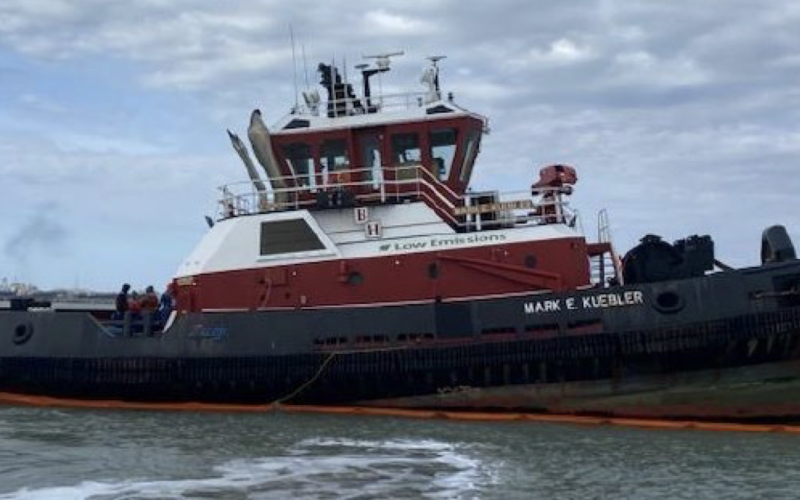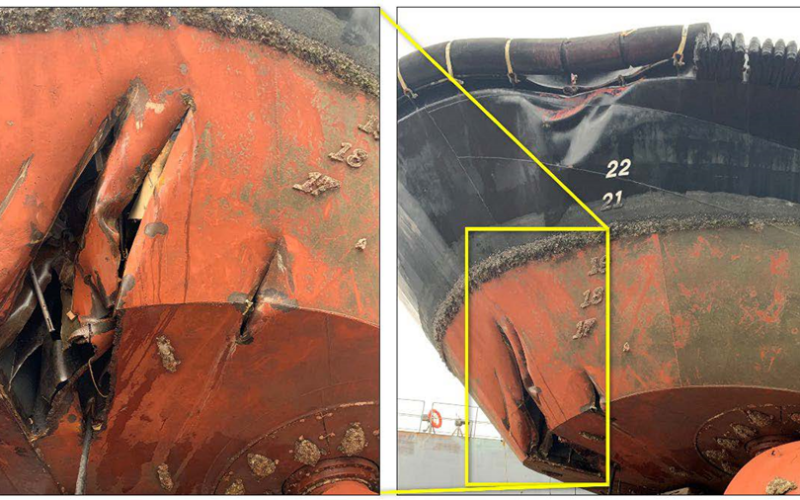A tugboat assisting a tanker arriving in the Corpus Christi Ship Channel was pulled toward the ship by hydrodynamic forces, resulting in a collision and the ship’s propellor cutting the hull of the tug, according to a National Transportation Safety Board report on the January 2023 accident.
The 98’x42’ tugboat Mark E Kuebler and the 1,092’x197’ Saudi Arabia-flagged tanker Nisalah collided in the channel near Ingleside, Texas, on Jan. 22, 2023.
The Kuebler’s hull was breached by the tanker’s propeller, which was also damaged in the collision, with total damages of nearly $7 million in damages. There were no injuries.
“A small vessel operating near a larger vessel must maintain a safe operating distance or have sufficient reserve power to counteract the hydrodynamic forces to avoid being pulled into the other vessel and risking collision,” the NTSB report says.
“If a small vessel must operate near a larger vessel – such as a tugboat conducting harbor-assist operations – the operator of the smaller vessel should be aware of the hazards caused by hydrodynamic forces and, if necessary, maintain a safe distance until the larger vessel slows and the hydrodynamic forces are reduced.”
The Nisalah was making an inbound transit through the Aransas Pass and Corpus Christi Ship Channel to the South Texas Gateway Terminal in Ingleside, Texas, where the ship was scheduled to load a cargo of crude oil.
As the Nisalah arrived, five tugboats were dispatched for harbor-assist operations. The Mark E Kuebler, which had five crewmembers aboard, was assigned to the starboard quarter position when it met the Nisalah at 1528 near buoys 19 and 20 in the Corpus Christi Ship Channel.
The Ted C Litton was assigned to the starboard bow; the Mercury was assigned to center lead forward (bow); and the Apollo was assigned to center lead aft (stern). The Connolly M was tasked to stand by and assist where needed.
When the Mark E Kuebler met the tanker, the Apollo was made up to the stern. The other tugboats were transiting on either side of the Nisalah and had not yet made up to the tanker. For a few minutes, the Mark E Kuebler also transited near the Nisalah, “pacing” the tanker along its starboard quarter. The mate was operating the tugboat, and the captain was in his stateroom. The Nisalah’s speed over ground was 9.6 knots.
The Mark E Kuebler’s hawser and winch were located on the bow of the tugboat. The mate stated that the chock on the Nisalah—through which the tugboat’s hawser would be made up—was located where the tanker’s hull curved inward toward the stern and flared outward from the waterline to the deck edge. Therefore, the mate decided that he would turn the tugboat around and transit in the astern direction so that, when made up, the hawser would tend forward from the tanker and the tugboat could lie alongside the tanker where the side of the ship’s hull was vertical.
To prepare to move into position, the Mark E Kuebler mate used the Z-drives to spin the tugboat clockwise 180° (see figure 4). The mate stated that, while completing the spin maneuver, the tugboat fell back near the stern of the Nisalah, so he increased power on the tugboat’s engines to regain position on the tanker’s starboard quarter.
According to the mate, as the Mark E Kuebler transited in the astern direction, the tugboat had about 50–60 feet of separation from the tanker. However, as the tugboat moved forward on the tanker, the stern of his vessel began to be drawn in toward the Nisalah. The mate increased engine power and attempted to steer the tugboat’s stern away from the Nisalah, but the tugboat continued to be pulled toward the tanker. As the Mark E Kuebler closed on the Nisalah, its speed was 11.6 knots.
“As the tanker was moving through the channel at nearly 10 knots, the mate of the tugboat decided to turn the tugboat around and transit backward to get in the tug’s assigned position,” according to the NTSB summary. “During the turn, the tugboat fell back toward the stern of the tanker. The tugboat mate increased the speed and power to try to regain position, but was drawn in toward the tanker by hydrodynamic forces and the two collided. NTSB found the tugboat had insufficient reserve power to counteract the hydrodynamic forces due to the transit speed of the vessels.”
As the tugboat attempted to move into position, its speed increased to 11.6 knots, just 1.4 knots less than its maximum rated ahead speed, according to the NTSB report. Investigators noted that “higher speed reduces the amount of reserve propulsion power available to the operator.”
At about 3:30 p.m., the Nisalah pilots and bridge team heard a noise and felt the ship shudder.
At the same time, the tanker’s engine speed, which had been 50 rpm, dropped to 33 rpm (without any propulsion order from the bridge or engine control room) and then accelerated again, returning to the original rpm after a brief settling-out period.
The mate stated that the mast and stacks of the Mark E Kuebler struck the hull of the Nisalah’s stern first, then the stern of the tugboat hit the tanker. Unknown to the tugboat crew at the time, the Nisalah’s propeller had struck the Mark E Kuebler, slicing through the tugboat’s hull. After the collision, the tugboat fell back astern of the tanker. Shortly thereafter, the Mark E Kuebler’s captain came to the wheelhouse and took control of the vessel.
The Nisalah master and pilot 3 went to the starboard bridgewing and looked down at the starboard quarter. They observed the mast on the Mark E Kuebler had been bent over, so the pilot called the tugboat to confirm that the vessel was okay. The Mark E Kuebler captain responded that the tugboat’s mast had hit the tanker but was otherwise fine, and the tugboat would continue the job.
However, shortly after, the tugboat captain radioed the Nisalah pilot again to state that the tugboat was getting a bilge high-water alarm. In response, the pilot ordered the Connolly M to switch out with the Mark E Kuebler at the starboard quarter position (no lines were passed between the tugboat and tanker at any time before or during the casualty). The Mark E Kuebler crew inspected the tugboat and discovered water flooding into the Z-drive machinery room.
Water continued to rise in the Mark E Kuebler’s Z-drive machinery room. Because of the danger of sinking due to the flooding, the captain of the
Mark E Kuebler intentionally grounded the tugboat in the bank outside of the Corpus Christi Ship Channel. The Nisalah pilots and crew saw no indications of damage to their vessel, and the tanker proceeded to the terminal and moored without further incident.
“Owners and operators of Z-drive tugboats that perform harbor-assist operations should set speed limits for advanced maneuvers such as stern-first approaches,” the report said. “These limits may vary for different classes of tugboats based on design. Tugboat operators should communicate these limits to ship masters or pilots in command of the vessels that they are assisting before engaging in these maneuvers.”
Following the collision, the tugboat’s operating company G&H Towing instituted a policy limiting stern-first landings of tugboats on assisted vessels to speeds of 7 knots or less.
The full NTSB report Marine Investigation Report 24-04 is available online.





